JOHNE'S CONTROL IN DAIRY HERDS
2020-09-25 15:11:01Veterinarians Dr. Pete Orpin and Dr. Dick Sibley and Dr. Karen Bond (PhD student) provide an excellent overview of Johne’s disease, targeted at dairy farmers and veterinarians. The article appears in the UK magazine In Practice. The magazine publishers have generously provided readers of Johnes.org news free access to the full article. The article nicely describes the disease, its importance, and measures to control it with lovely graphics. It also briefly describes UK’s national Johne’s control program, which has many similarities to that of the US.
The second article of the series goes into more depth about on-farm control measures and the UK’s National Johne’s Management Plan. It will be featured in coming news stories on this website.
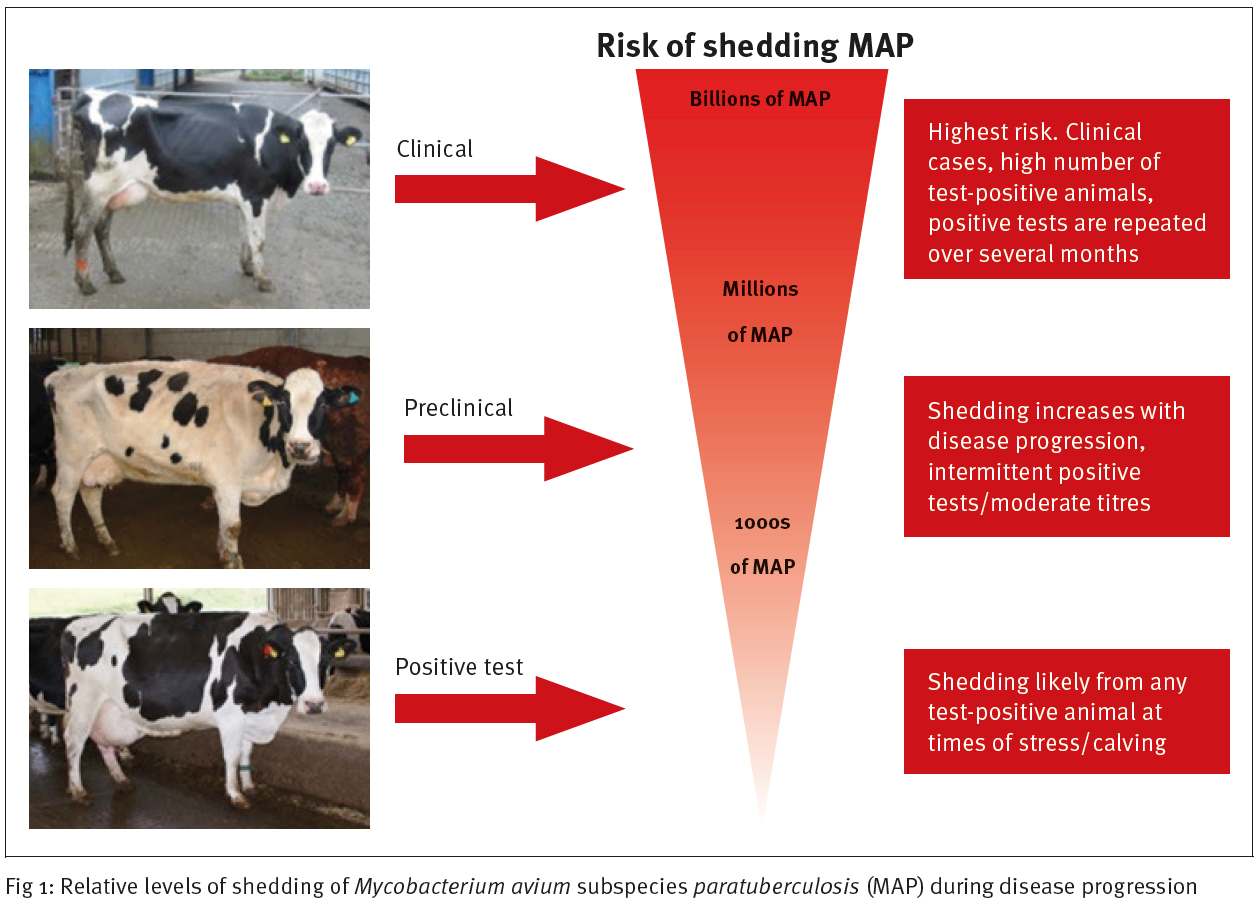
About the authors:
Dr. Pete Orpin qualified from the University of Bristol in 1983 and worked as a farm vet within the Park Vet Group in Leicestershire for 35 years before retiring. He is a founding member of Action Group Johne’s and chair of its technical group, and is a director of Myhealthyherd.
Dr. Dick Sibley qualified from the University of Bristol in 1977 and is currently a practicing vet in Witheridge, Devon. A founding member of Action Group Johne’s and director of Myhealthyherd, he has had a long interest in the practical management and control of infectious diseases, including bovine viral diarrhea, tuberculosis and Johne’s disease.
Dr. Karen Bond qualified from the University of Glasgow in 2000 and works as a veterinary adviser for National Milk Records, where she has a special interest in the testing and management of infectious disease. She is currently undertaking a PhD in Johne’s disease transmission on dairy farms.
Comment: I wish to thank the publisher, BMJ, for granting access to these excellent articles on Johne’s disease published in In Practice, a publication of the British Veterinary Association.
TWO NEW JD VACCINES!
2020-09-18 16:09:43This year the laboratory of Dr. Adel Talaat, School of Veterinary Medicine, University of Wisconsin-Madison, has reported on two unique vaccines to combat Johne’s disease. The first, a nanovaccine, was reported in npj Vaccines February 14, 2020. The second, a live attenuated (avirulent) vaccine (LAV) was reported in the journal Microorganisms September 17, 2020. Both publications describing these vaccines are Open Access.
A single dose polyanhydride-based nanovaccine against paratuberculosis infection
Abstract
Mycobacterium avium subsp. paratuberculosis (M. paratuberculosis) causes Johne’s disease in ruminants and is characterized by chronic gastroenteritis leading to heavy economic losses to the dairy industry worldwide. The currently available vaccine (inactivated bacterin in oil base) is not effective in preventing pathogen shedding and is rarely used to control Johne’s disease in dairy herds. To develop a better vaccine that can prevent the spread of Johne’s disease, we utilized polyanhydride nanoparticles (PAN) to encapsulate mycobacterial antigens composed of whole cell lysate (PAN-Lysate) and culture filtrate (PAN-Cf) of M. paratuberculosis. These nanoparticle-based vaccines (i.e., nanovaccines) were well tolerated in mice causing no inflammatory lesions at the site of injection. Immunological assays demonstrated a substantial increase in the levels of antigen-specific T cell responses post-vaccination in the PAN-Cf vaccinated group as indicated by high percentages of triple cytokine (IFN-γ, IL-2, TNF-α) producing CD8+ T cells. Following challenge, animals vaccinated with PAN-Cf continued to produce significant levels of double (IFN-γ, TNF-α) and single cytokine (IFN-γ) secreting CD8+ T cells compared with animals vaccinated with an inactivated vaccine. A significant reduction in bacterial load was observed in multiple organs of animals vaccinated with PAN-Cf, which is a clear indication of protection. Overall, the use of polyanhydride nanovaccines resulted in development of protective and sustained immunity against Johne’s disease, an approach that could be applied to counter other intracellular pathogens.
A protective vaccine against Johne’s disease in cattle
Abstract
Johne’s disease (JD) caused by Mycobacterium avium subsp. paratuberculosis (M. paratuberculosis) is a chronic infection characterized by the development of granulomatous enteritis in wild and domesticated ruminants. It is one of the most significant livestock diseases not only in the USA but also globally, accounting for USD 200–500 million losses annually for the USA alone with potential link to cases of Crohn’s disease in humans. Developing safe and protective vaccines is of a paramount importance for JD control in dairy cows. The current study evaluated the safety, immunity and protective efficacy of a novel live attenuated vaccine (LAV) candidate with and without an adjuvant in comparison to an inactivated vaccine. Results indicated that the LAV, irrespective of the adjuvant presence, induced robust T cell immune responses indicated by proinflammatory cytokine production such as IFN-, IFN-_, TNF-_ and IL-17 as well as strong response to intradermal skin test against paratuberculosis antigens. Furthermore, the LAV was safe with minimal tissue pathology. Finally, calves vaccinated with adjuvanted LAV did not shed M. paratuberculosis post-challenge, a much-desired characteristic of an effective vaccine against JD. Together, this data suggests a strong potential of testing LAV in field trials to curb JD in dairy herds.
Comments:
The LAV is among the first live vaccine to be tested in mice, then goats and now finally in this report, cattle. The early evidence suggests it will be a useful tool in the global effort to control Johne’s disease. However, assuming a company licenses one of the vaccines it will take several years to bring it to market.
The LAV did not produce the unsightly granulomas of traditional killed vaccines like Mycopar™. Below is the lesion score data from the LAV publication followed by a photo of a cow in Wisconsin vaccinated with Mycopar™ when she was just a calf. Regulations require that the Mycopar™ vaccine be administered in the brisket before the animal is 35 days old. The Mycopar™ vaccine is no longer being produced in the U.S.

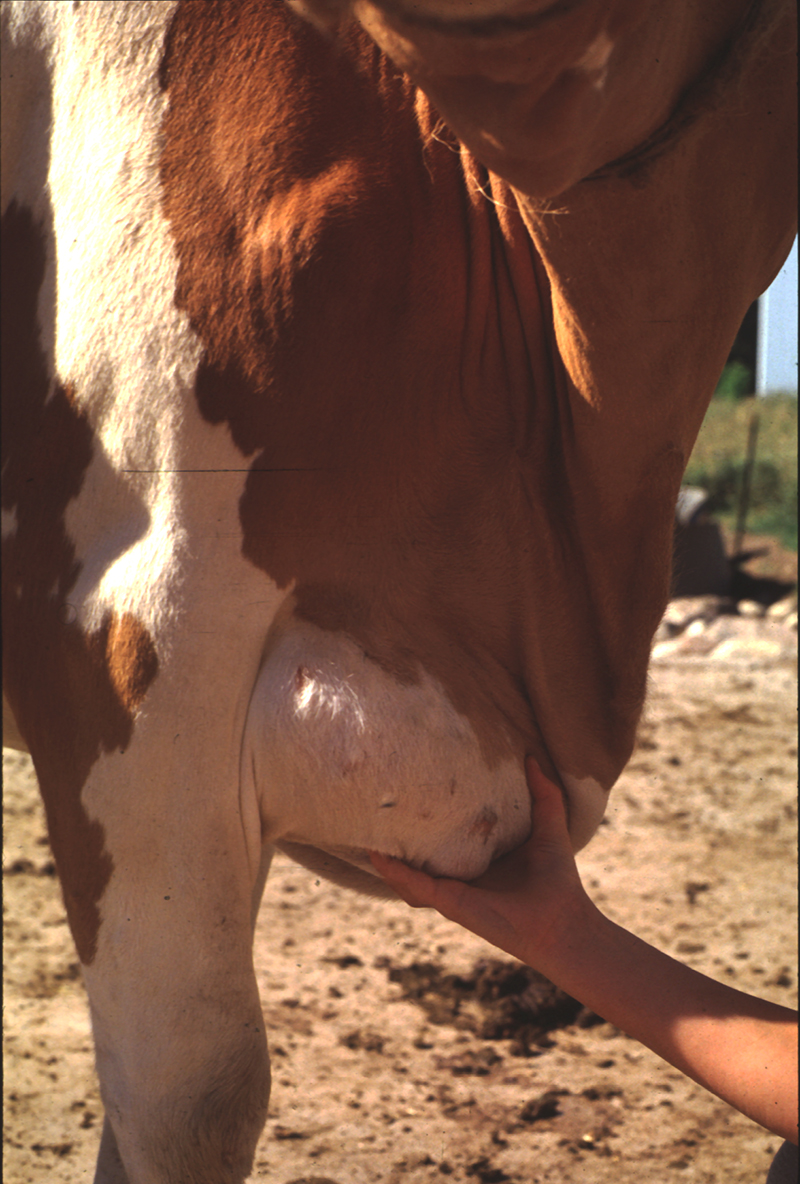
In countries with bovine tuberculosis (TB), caused by Mycobacterium bovis, it is vital that animals that are vaccinated against JD can be discriminated from those with bovine TB. In the study on the LAV, the authors reported:
Mycopar™ vaccinated calves displayed significant skin indurations after the injection of M. bovis PPD clearly showing cross-reactivity to bovine TB. On the other hand, none of the LAV vaccinated calves developed significant skin indurations against M. bovis PPD at 12 MPC, despite mounting a robust reaction to Johnin. In fact, pgsNQ vaccinated calves did not respond to the M. bovis PPD at the 2 MPV time point, as well. This lack of reactivity to bovine PPD feature, could be crucial for further developing the LAVs used here as DIVA compliant vaccines (vaccines with a simple assay to differentiate infected from vaccinated animals). The DIVA-compliant vaccines would be very useful to implement to control paratuberculosis in countries where bovine tuberculosis is prevalent and farmers hesitate to use the current JD vaccine. The observed cross reactivity to M. avium PPD by calves from all vaccine groups is expected because of the close similarity between M. avium and M. paratuberculosis but could be employed as a further confirmation of developing immunity against paratuberculosis.
MAP IN DAIRY PRODUCTS
2020-09-14 15:40:27Manju Singh and 8 colleagues from universities in India reported on tests for MAP in a variety of dairy products purchased from retail stores. Their publication (16 pages with 55 references) appears in the August 2020 issue of the Journal of Experimental Biology and Agriculture Science (JEBS). All the articles published by JEBAS Open Access.
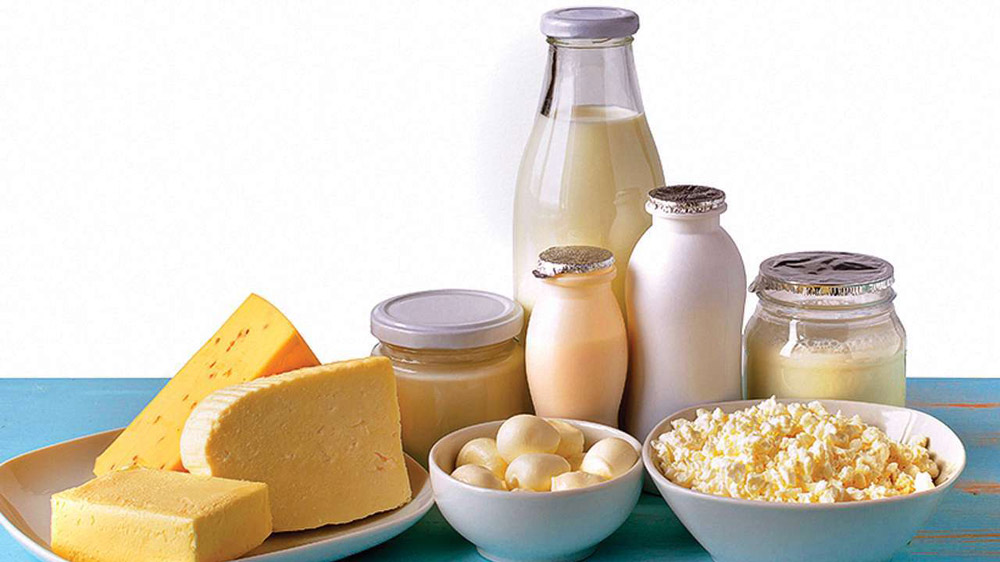
Abstract
Twelve types of milk products belonging to 22 market brands were purchased from local shops in South Uttar Pradesh and were screened for the presence of Mycobacterium avium subspecies paratuberculosis (MAP) as major contaminant using six tests (microscopy, Indirect Fluorescent Antibody Test, IS900 PCR, Indigenous Enzyme linked Immuno Sorbent Assay, dot_ELISA, and Latex agglutination Test). Sample positive in any one of the six tests was considered as positive. Of 276 milk products screened, the cumulative bio-presence of MAP was, 52.8% (146) and was highest in butter (75.0%), followed by curd (66.0%), buttermilk (52.9%), lassi (50.0%), cheese (40.0%) and ice-cream (28.5%). Bio-typing of MAP DNA from milk products using IS1311 PCR_REA revealed presence of ‘Indian Bison Type’ as a major biotype. Kappa (0.700 – 0.815) and two-tailed p (<0.0001–1.0) values for six tests were significant for all six tests. This study for the first time revealed large scale contamination of ‘milk products’ marketed by leading commercial brands in India, with MAP bacilli and therefore not safe for human consumption.

Comment: Some of the assays used in this study measured the presence of antibodies against MAP, not the organism. However, by IS900 PCR, samples of curd, butter, ice cream, butter, and cheese were all found positive at rates ranging from 6.0% to 13.8%. None of the assays used could determine if the MAP that was detected was alive. Regardless, it indicates that MAP is spilling over from domestic animals into the food supply. This Wikipedia link describes Indian dairy products.
U.S. MAP EPIDEMIC
2020-09-04 17:19:31In 1915 the Wisconsin Experiment Station began a study of Johne’s disease. This tradition continues at the University of Wisconsin to this day. Today’s news post looks at studies in the U.S. that have tried to estimate the herd-level prevalence of this infection for dairy herds, i.e. percentage of MAP-infected herds. Also, because this literature is often hard to access, the original publications from which the graphics below originate, are also provided.
In 1927 Hastings et al. published a 44-page report on Johne’s disease (Wisconsin Research Bulletin 81) with 121 references. In that report, the authors provided a graphic illustrating where Johne’s disease had been reported (below).
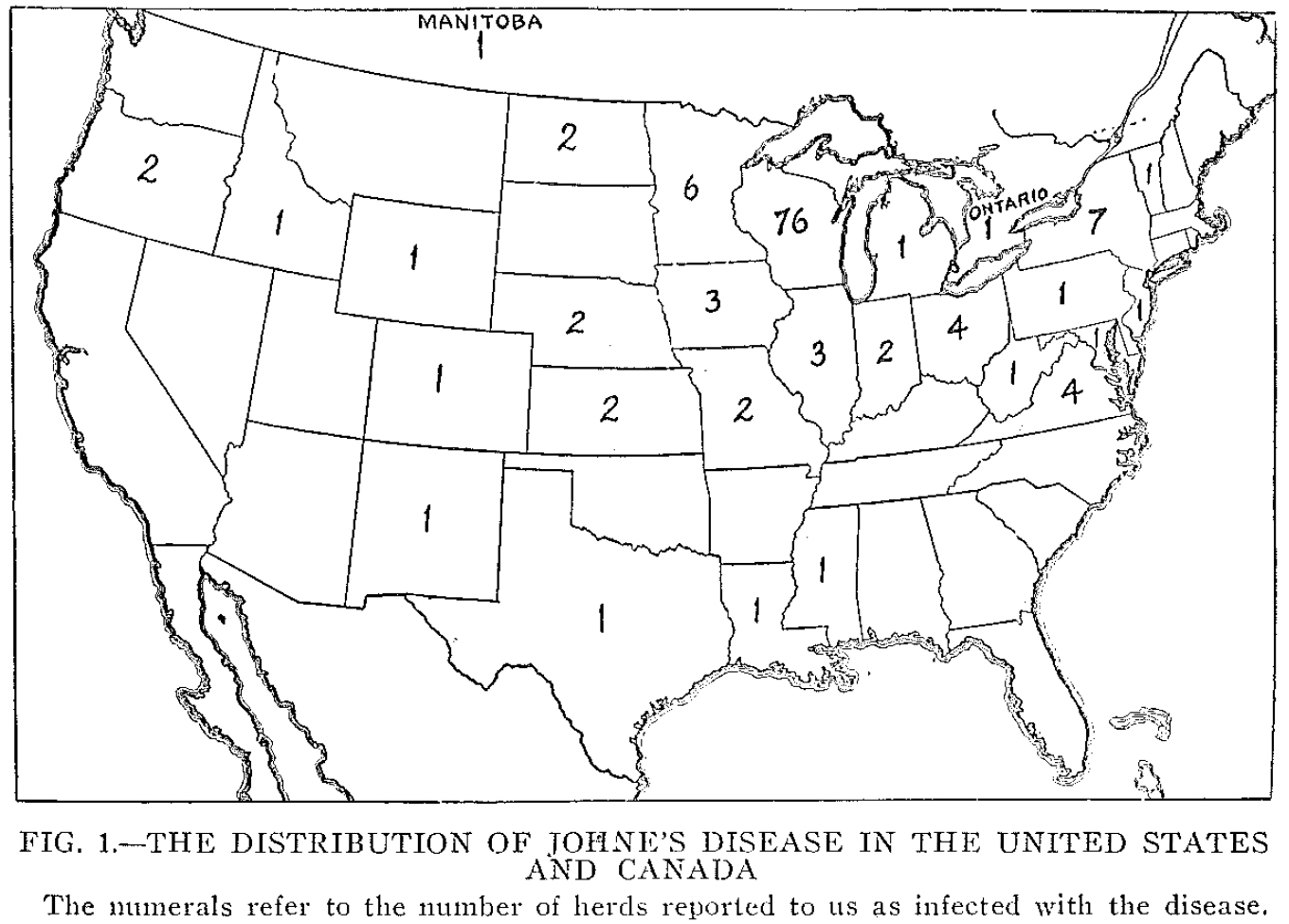
In 1976, at a meeting of the American Association of Bovine Practitioners, Dr. Aubrey Larsen reviewed developments in research on paratuberculosis and provided the results of two U.S. surveys, one in 1949 and one in 1971 (Proceedings of the 1976 AABP meeting).
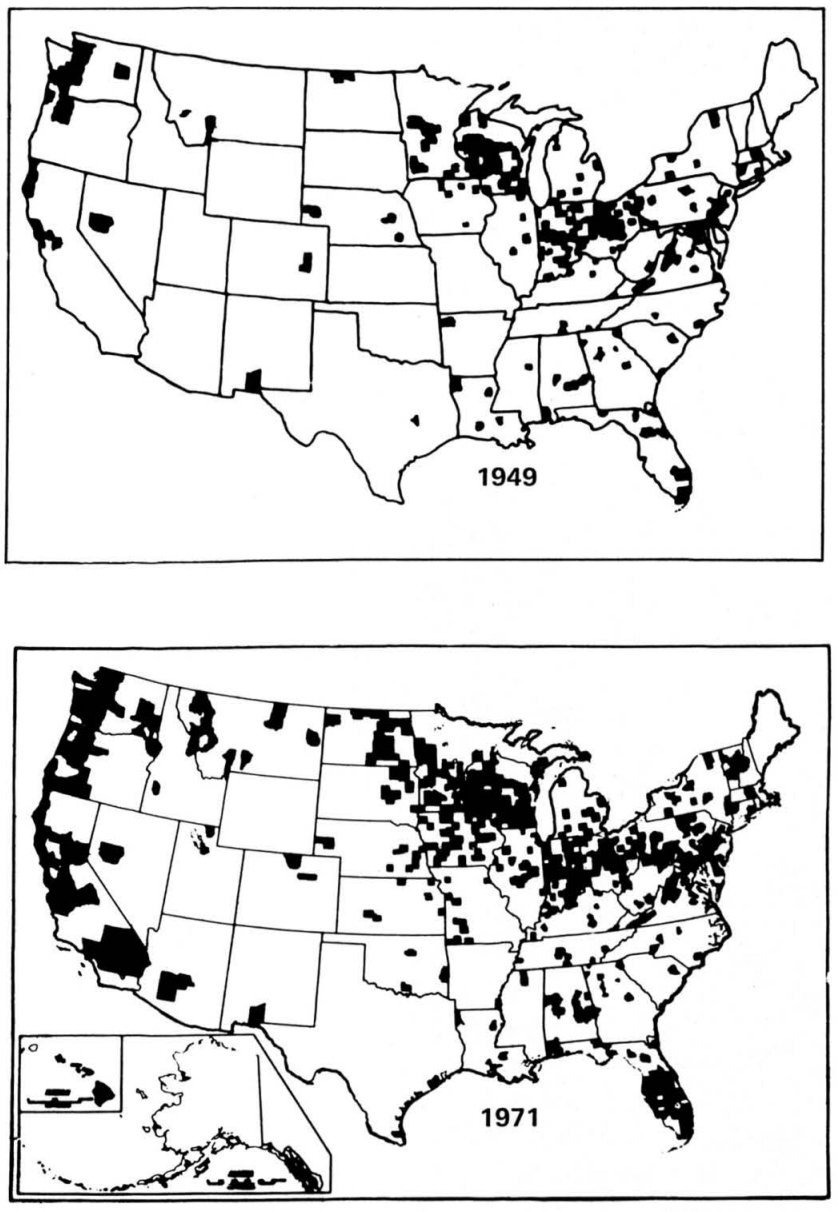
In 1996 the USDA surveyed U.S. dairy herds using an ELISA for serum antibodies against MAP. They used 3 definitions for a “positive”, i.e. MAP-infected herd: 1) herds with 1 or more ELISA-positive cows (40.6% of all herds), 2) herds with 2 or more ELISA-positive cows (16.8% of all herds), and 3) herds with 1 or more ELISA-positive cows and reports of clinical signs of Johne’s disease by herd owners (21.6% of all cows. The 21.6% figure is the one most often cited as herd-level MAP infection prevalence for U.S. dairy herds in 1996. Significant regional differences were only found for the second case definition.

In 2002 the USDA did another study for the purposes of comparing Johne’s disease diagnostic test accuracy and evaluating within-herd infection prevalence but did not attempt to estimate the herd-level prevalence of Johne’s disease in the U.S. After testing 7,238 dairy cows, they reported that the ELISA done on serum detected only 27.4% of fecal culture-positive cows, showing that any survey done using ELISA methods underestimates the number of cows that are truly MAP-infected and shedding MAP in their feces, i.e. infectious. However, the ELISA was good at detecting the cows shedding the highest amounts of MAP in their feces.
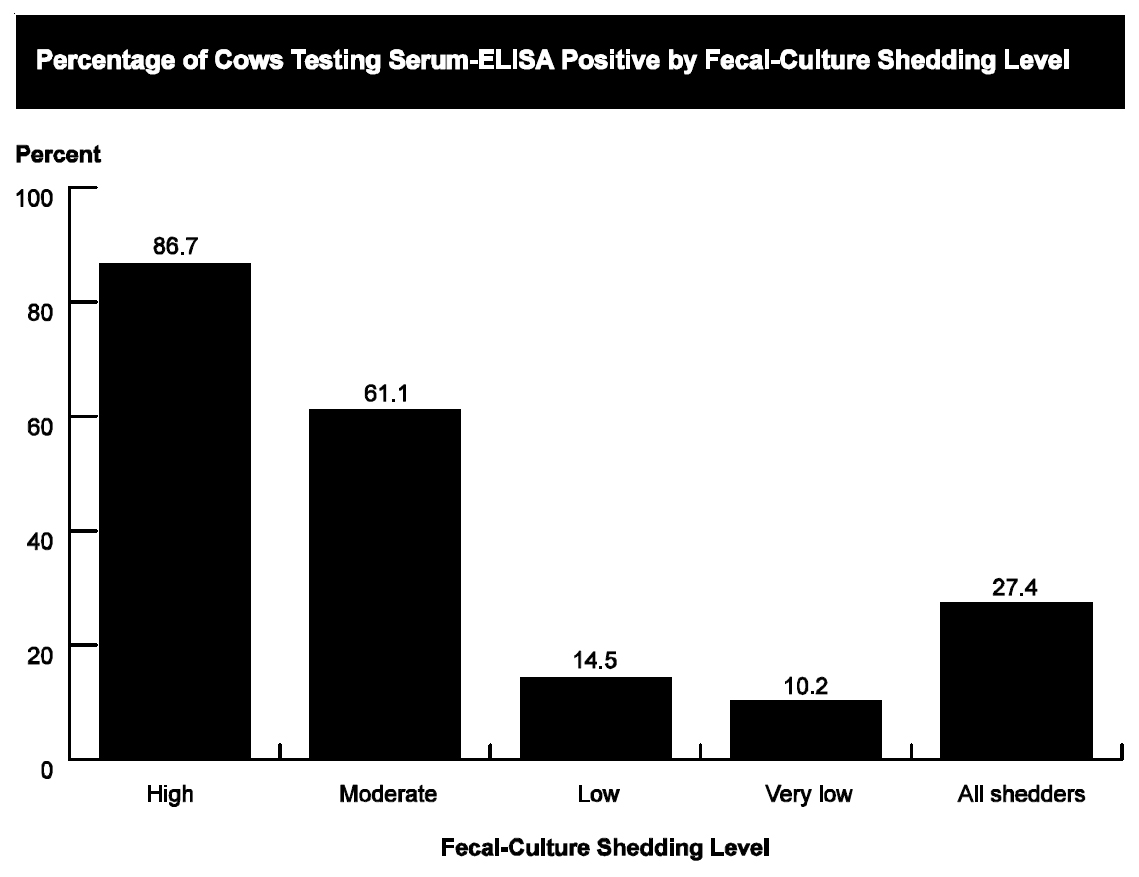
In 2007 the USDA repeated the national survey of U.S. dairy herds but used environmental fecal culture on 6 samples per farm as the diagnostic test. That survey found that MAP was isolated from at least one environmental sample on 68.1% of operations, and herd-level prevalence was higher for larger herds. They reported: “About one-fourth of operations had six culture positive environmental samples. Operations with one to five culture-positive samples were less common. These results suggest that at least one-fourth of U.S. dairy operations may have a relatively high percentage of infected cows in their herds." A clear relationship between herd size and frequency of finding MAP was shown.
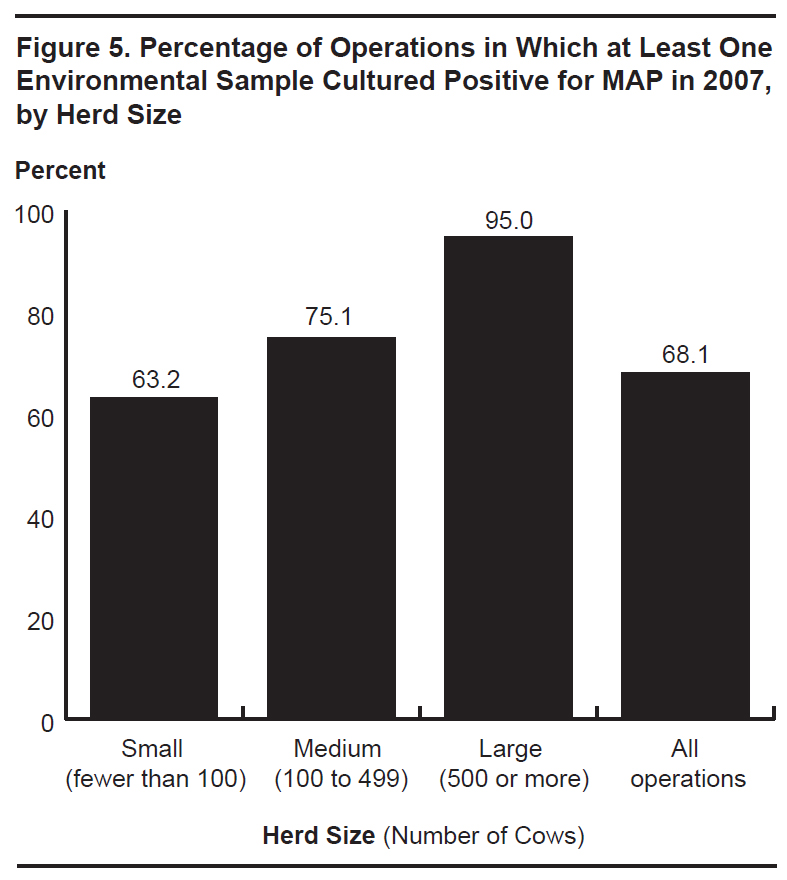
The rate of detection of MAP-infected herds is called the apparent prevalence (percentage of test-positive herds). Using this data, Dr. Jason Lombard et al. (Preventive Veterinary Medicine 108:234, 2013) used epidemiological methods to estimate the true herd-level prevalence or paratuberculosis in U.S. dairy herds at 91.1% of U.S. dairy herds (95% probability interval, 81.6 to 99.3%).
Comment: Chronic infectious diseases cause by slow-growing pathogens like MAP spread insidiously as herd owners buy and sell animals without considering the MAP infection status of the source herds. Although researchers have repeatedly tried to call attention to this problem, more acute or immediate challenges for dairy herd owners divert attention away from this growing problem. Early in the start of this epidemic clear warnings were issued:
“The aim of this bulletin is to call the attention of veterinarians and breeders to Johne’s disease, which, it is felt, is not recognized by many, in order that steps may be taken to prevent its introduction into still healthy herds, and to gradually eliminate it from affected herds.” (Beach & Hastings, 1922)
"Dr. V.A. Moore has compared the present position of Johne's disease with that of bovine tuberculosis 60 years ago and has prophesied that, if not controlled, it may become a more troublesome scourge for future generations than tuberculosis is for the present generation of cattle-owners." (Larson, et al., 1924).
Their warnings remain true today and their aim, to raise awareness, is the same aim as that of this website.
Below is my view of the global epidemic curve. If MAP is a zoonotic pathogen, the prevalence of this infection in food-producing animals does not bode well for the health of humanity.
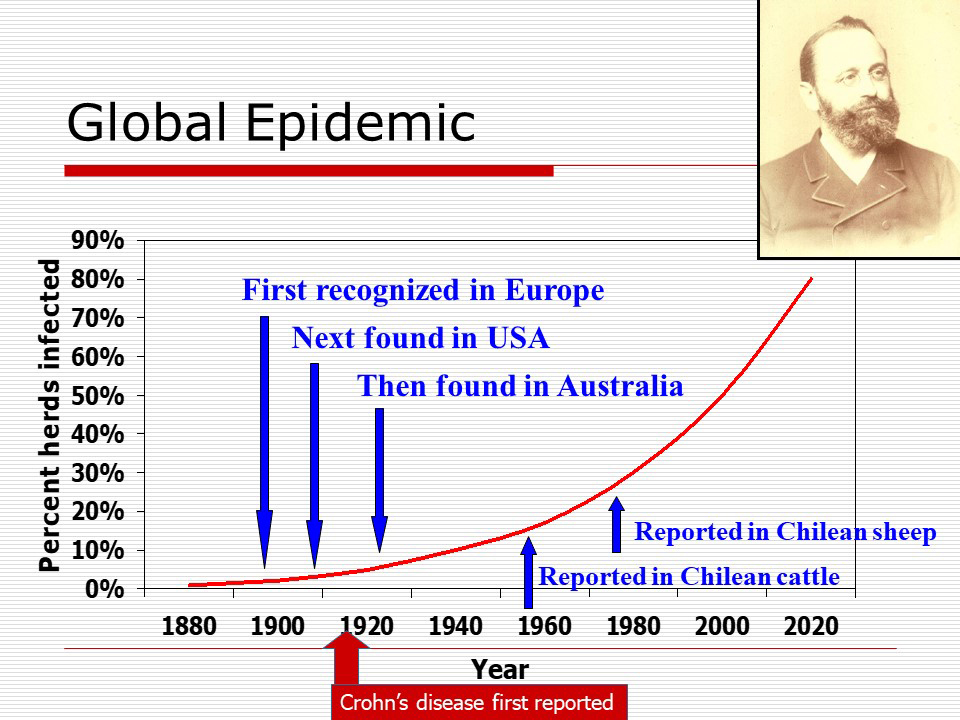
Explanatory note: Chilean reports of Johne’s disease are used as an example of how MAP is spreading to developing countries. The photo is that of Dr. H.A. Johne. For more on the history of Johne’s disease check out the history timeline.
EFFECT OF EXPOSURE AGE AND MAP DOSE
2020-08-31 16:16:46Mortier & colleagues from the Department of Production Animal Health, University of Calgary in Canada conducted a trial to evaluate the effect of calf age at the time of MAP exposure and dose of MAP ingested on the rate of infection progression. This publication appeared in 2014 but is so helpful in understating the epidemiology and pathogenesis of MAP infections in dairy calves it is being highlighted in today’s news positive. This Open Access article appears in the journal Veterinary Research.
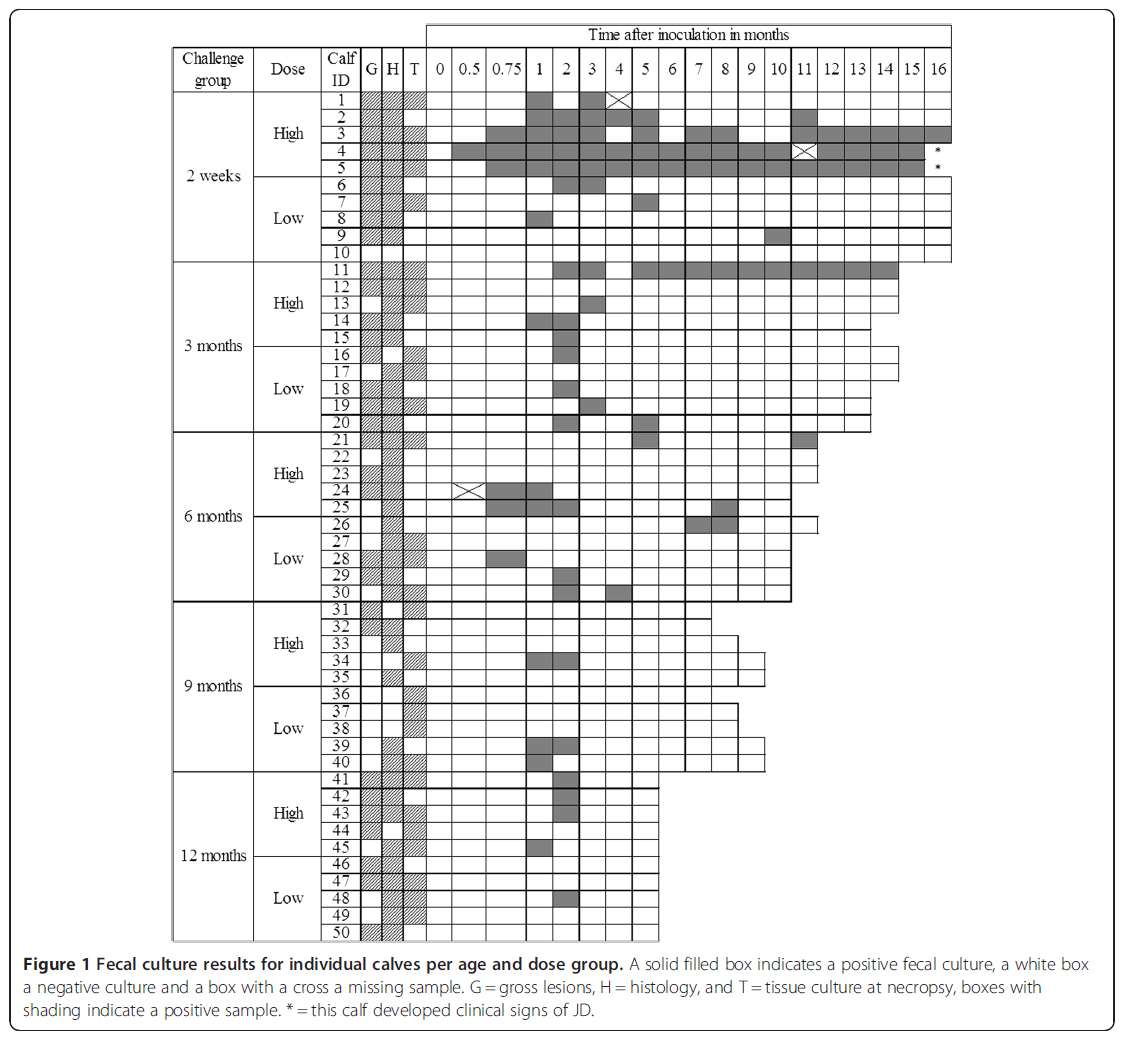
Abstract
Although substantial fecal shedding is expected to start years after initial infection with Mycobacterium avium subspecies paratuberculosis (MAP), the potential for shedding by calves and therefore calf-to-calf transmission is underestimated in current Johne’s disease (JD) control programs. Shedding patterns were determined in this study in experimentally infected calves. Fifty calves were challenged at 2 weeks or at 3, 6, 9 or 12 months of age (6 calves served as a control group). In each age group, 5 calves were inoculated with a low and 5 with a high dose of MAP. Fecal culture was performed monthly until necropsy at 17 months of age. Overall, 61% of inoculated calves, representing all age and dose groups, shed MAP in their feces at least once during the follow-up period. Although most calves shed sporadically, 4 calves in the 2-week and 3-month high dose groups shed at every sampling. In general, shedding peaked 2 months after inoculation. Calves inoculated at 2 weeks or 3 months with a high dose of MAP shed more frequently than those inoculated with a low dose. Calves shedding frequently had more culture-positive tissue locations and more severe gross and histological lesions at necropsy. In conclusion, calves inoculated up to 1 year of age shed MAP in their feces shortly after inoculation. Consequently, there is potential for MAP transfer between calves (especially if they are group housed) and therefore, JD control programs should consider young calves as a source of infection.
Comment: Since calves shed MAP in feces soon after infection, it’s possible that they can transmit the infection to other calves that they are in contact with. Rather than change management practices to limit calf to calf contact, it seems more rational to invest efforts to prevent calves from becoming MAP-infected in the first place. This is done by: 1) testing the adult herd regularly, 2) culling or isolating infected cows, 3) calving test-negative cows in clean maternity pens, 4) promptly removing calves from cows, and 5) insuring colostrum fed to calves is collected only from test-negative cows and that it is collected with utmost care to avoid fecal contamination.
IRISH JD PROGRAM
2020-08-22 17:06:56Jordan et al. published a thoughtful assessment of the Irish Johne’s disease Program launched in 2018. Their Open Access article was published in the Irish Veterinary Journal August 14, 2020. This is valuable reading for countries thinking of developing comparable programs or revising their existing national program.

Abstract
The Irish dairy industry has established a reputation for the production of safe and healthy dairy products and is seeking to further expand its export market for high value dairy products. To support its reputation, stakeholders aim to control Johne’s disease. To assist decision-makers determine the most appropriate design for an Irish programme, a narrative review of the scientific literature on the epidemiology of Johne’s disease, and selected control programmes throughout the world was undertaken. Two modelling studies specifically commissioned by Animal Health Ireland to assess testing methods used to demonstrate confidence of freedom in herds and to evaluate a range of possible surveillance strategies provided additional information. The majority of control programmes tend to be voluntary, because of the unique epidemiology of Johne’s disease and limited support for traditional regulatory approaches. While acknowledging that test performance and sub-clinical seronegative shedders contributes to the spread of infection, a range of sociopolitical issues also exist that influence programme activities. The paper provides a rationale for the inclusion of a Veterinary Risk Assessment and Management Plan (VRAMP), including voluntary whole herd testing to identify infected herds and to support assurance-based trading through repeated rounds of negative testing, national surveillance for herd-level case-detection, and improved understanding of biosecurity management practices. Identification and promotion of drivers for industry and producer engagement in Ireland is likely to guide the future evolution of the Irish Johne’s Control Programme (IJCP) and further enhance its success. The provision of training, education and extension activities may encourage farmers to adopt relevant farm management practices and help them recognize that they are ultimately responsible for their herd’s health and biosecurity.
Comment: As described in the article by Jordan et al., VRAMPs are a tool to evaluate individual farm risk for the introduction and spread of MAP and educate producers on steps they can take to reduce these risks. They are typically conducted by trained private veterinary practitioners and involve an on-farm questionnaire on the management practices pertinent to MAP control. The responses to the questionnaire enable private veterinary practitioners to determine the sources of risk for the entry and spread of MAP in a herd. Farm-specific recommendations for MAP prevention and control are developed in conjunction with the farmer.
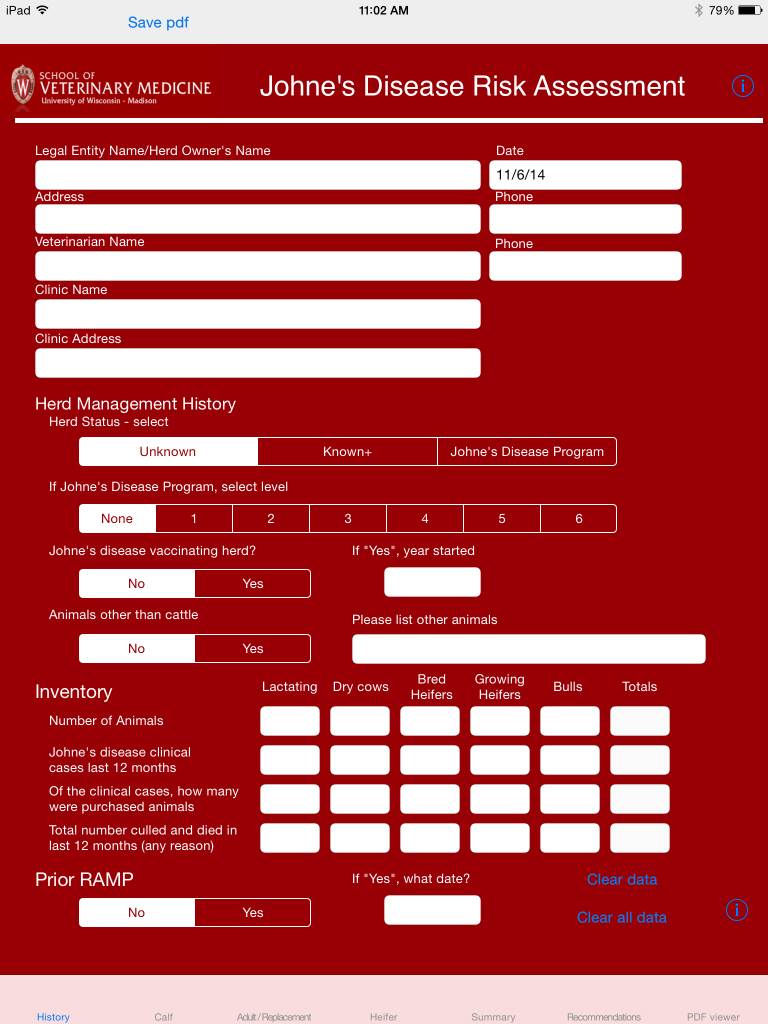
Many countries have a risk assessment and management plan (RAMP) as a component of their national program. The University of Wisconsin School of Veterinary Medicine, Food Animal Medicine Program has converted the risk assessment forms used in the U.S. national program into an App for iPads. It is one of 16 such Apps used for various health assessments in dairy herds.
DAIRY: MILK ELISAS
2020-08-15 16:03:46Dr. Conor McAloon from the Section of Herd Health and Animal Husbandry, School of Veterinary Medicine, University College Dublin, Ireland, together with 10 other colleagues analyzed data from dairy herds in the national Johne's Disease Control Programme (JDCP) in Ireland from January 2014 to December 2015 inclusive, consisting of 42,657 milk recordings from 18,569 cows across 187 dairy herds. Their publication in the Journal of Dairy Science appeared online July 31, 2020.
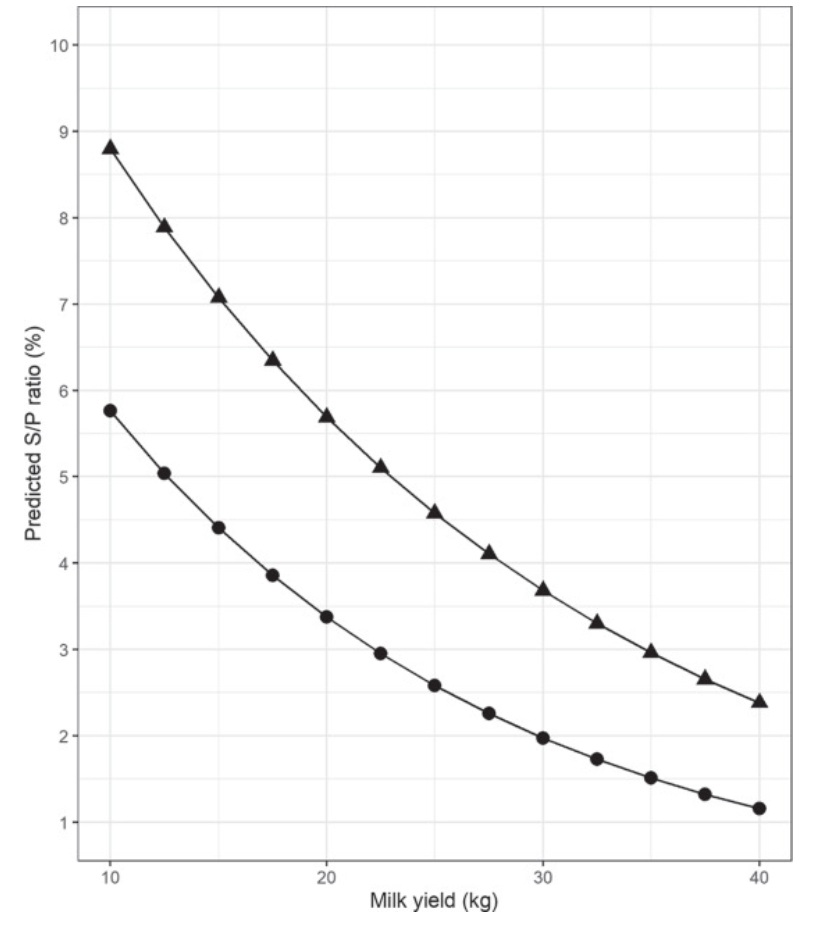
Abstract
Antibody-detecting tests for Mycobacterium avium ssp. paratuberculosis (MAP) have low sensitivity and imperfect specificity for detection of infection. Sensitivity increases as the disease progresses. Aside from infection status and stage of disease, several factors affect test performance. These factors have not yet been studied in dairy cows producing lower volumes of milk with higher solids concentration, such as those managed in low-input, pasture-based production systems. Furthermore, the effect of correcting for these associations on individual and herd test status is also unknown. The first objective of this study was to examine the relationship between MAP antibody response in milk and milk yield, somatic cell count (SCC), fat and protein contents, and stage of lactation in dairy cows enrolled in the national Johne's Disease Control Programme (JDCP) in Ireland. The second objective was to examine the effect of correcting the antibody response for these associations on the test status of individual cows and herds, given that individual tests are often used to define a herd's status. Data were extracted for herds in the JDCP from January 2014 to December 2015 inclusive, consisting of 42,657 milk recordings from 18,569 cows across 187 dairy herds. Two linear regression models were constructed to investigate the association between log-transformed MAP sample-to-positive ratio and milk recording data and in primi- and multiparous cows. Days in milk was modeled as a B-spline in each model, and cow and herd were included as random effects. Across both models, natural log-transformed MAP antibody response was negatively associated with milk yield, positively associated with protein and fat production, and had a curvilinear association with log-transformed SCC. The association between MAP antibody response and days in milk varied over the course of the lactation. However, when combined, these variables explained only 5.1% of the variation in the antibody response of the population. After correcting for these associations, 93 multiparous cows and 20 primiparous cows changed category (negative, suspect, or positive). When considered at the herd-test level, out of a total of 531 herd tests, 1 herd changed from negative to positive, and 5 herds changed from positive to negative. This study provides useful information to aid in the interpretation of antibody results for herds testing animals for the presence of MAP infection. At an overall population level, correction of the serological response for non-disease-associated factors has the potential to change the status of only a small number of cows. At the herd level, the proportion of herds changing status was minimal. However, depending on the implications of a herd-level serological diagnosis, consideration should be given to correcting for these non-disease-associated variables within the context of national JD control programs.
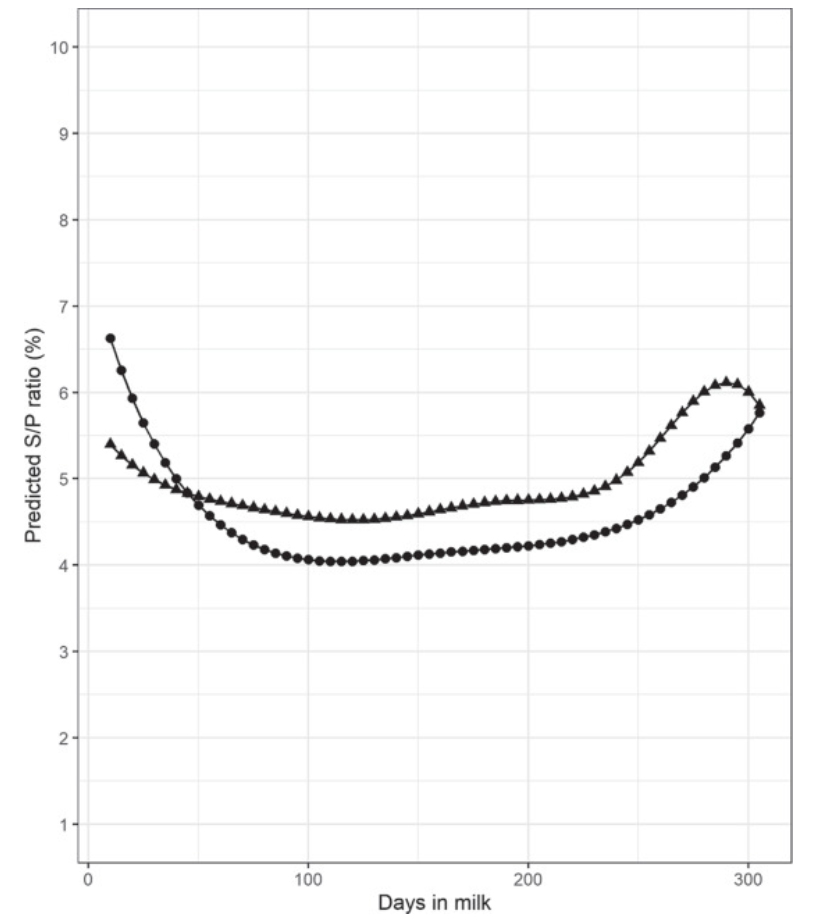
Comment: The above graphic from McAloon's paper illustrate that ELISAs for Johne’s disease done on milk samples are best done early or late in lactation. This study again shows a direct relationship between the magnitude of the ELISA value, called S/P value, and the yield of milk, i.e. higher ELISA S/P means lower milk yield (figure at the top of this page). Milk ELISAs are the least expensive testing option for dairy herds in most countries and are useful in controlling Johne’s disease and selecting cows for replacement.
MAP SURVIVAL IN CHEESE
2020-08-07 14:48:07It takes months for MAP to die off during the manufacture of Lighvan cheese, a semi-hard raw milk cheese traditionally made from sheep's milk in Lighvan, a village in East Azerbaijan, Iran.

Shahram Hanifian from the Department of Food Science and Technology, Biotechnology Research Center, Tabriz Branch, Islamic Azad University, Tabriz, Iran has reported on the survival of MAP during the production and ripening of Lighvan cheese. His publication appears in the November 2020 issue of the journal LWT – Food Science and Technology. [Open Access]
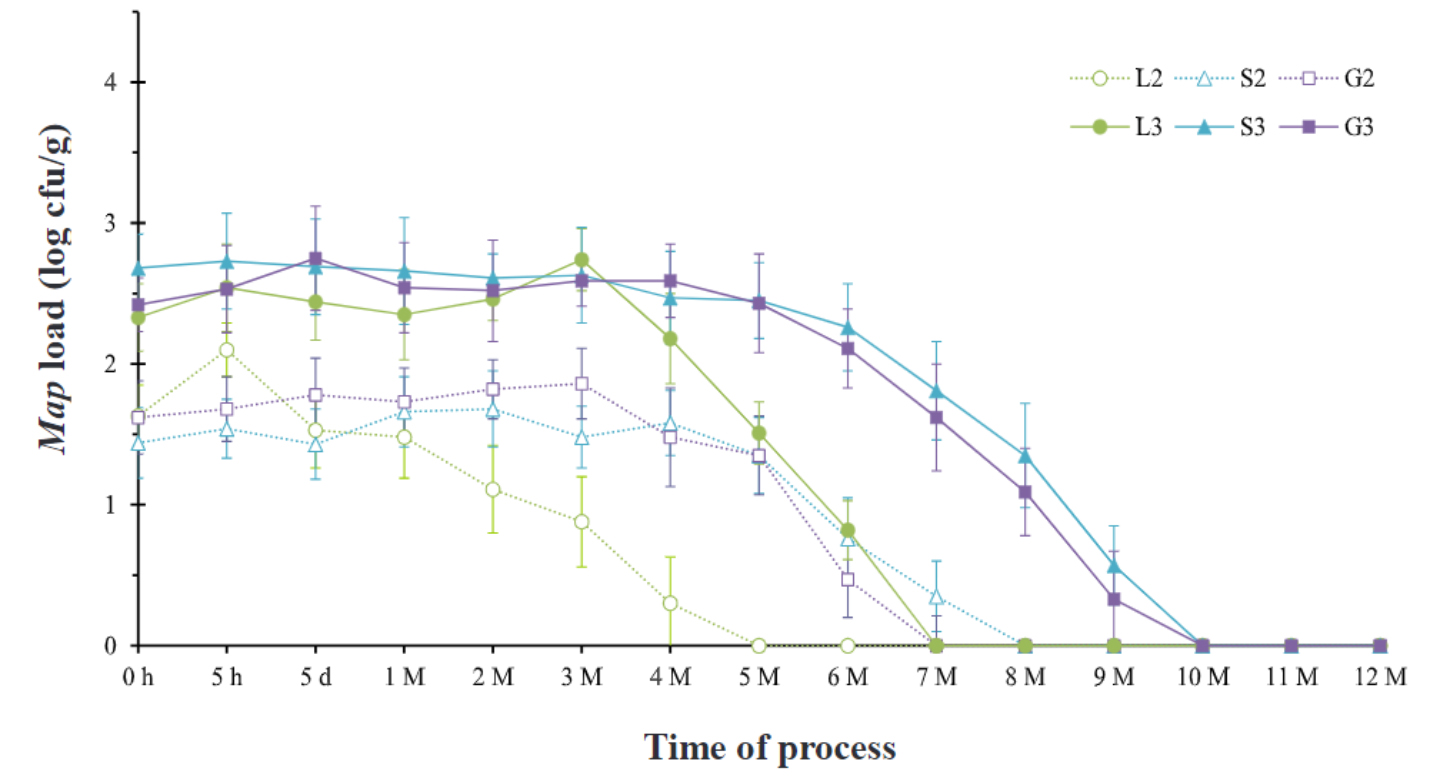
Abstract
Mycobacterium avium subsp. paratuberculosis (Map) is an important animal pathogen with a worldwide distribution that may contribute to Crohn's disease in humans. This study aimed to investigate the behavior of Map in Lighvan cheese with special reference to the strains of Map, inoculum load, and storage time. One laboratory and two native strains of Map were inoculated (102 and 103 Map cell/mL) to cheese milk. The behavior of Map throughout the manufacture, ripening, and storage stage of Lighvan cheese tracked using propidium monoazide (PMA) qPCR and culture examination. According to the results, PMA-qPCR showed parallel outcomes in comparison with the culture assay. Besides, in all cheese batches Map was not affected during the ripening; however, throughout the storage period Map population decreased depending on the strain of Map. Trend analysis revealed no significant difference between the persistence of sheep and goat strains, but in all cheese batches, these native strains persisted significantly (p < 0.05) longer than the laboratory strain. In all treatments, the decreasing rate of Map found independent of the initial inoculum load. Nonetheless, in the cheese batches with higher initial inoculum, Map persisted two months longer.
Comment: Meta-analysis has shown that MAP is strongly associated with an inflammatory bowel disease called Crohn’s disease. Studies in Iran support this. Human exposure to MAP likely comes mostly from foods of animal-origin and cheese is one such product. This publication extends observations by others on cheese that MAP can survive extended times. Compared with Western countries, the incidence of IBD is lower in Iran; however, during the past decade, unofficial reports have claimed the incidence appears to be increasing (Aghazedh, 2005). MAP infections in Iranian animals, which are on the rise, may be party responsible.
Links of relevance:
IBD in Iran – a review.
Association of MAP with Crohn’s disease in Iran.
Paratuberculosis in Iranian goats.
Paratuberculosis in Iranian sheep.
Paratuberculosis in Iranian dairy cattle.
ECO-FRIENDLY WAY TO KILL MAP
2020-08-02 15:49:18Dr. Judy Stabel and colleagues from the USDA-ARS-National Animal Disease Center, Ames, Iowa, USA compared new plant-based disinfectants to the more traditional phenolic and quaternary ammonium disinfectants in ability to kill MAP. Their publication appears in the September 2020 issue of the Journal of Microbiological Methods. This is a useful explanation of disinfectants for MAP and shows the contact time required for 100% killing, which is longer than for most microbes.
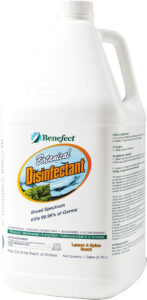
Abstract
Mycobacteria are difficult to kill due to the complexity of their cell wall. Further, Mycobacterium avium subsp. paratuberculosis (MAP) has one of the more elaborate cell wall compositions of all the mycobacteria. As a working pathogen within a research laboratory setting or as an environmental contaminant shed in the manure from infected animals, MAP is highly resistant to typical disinfectants. In the past, the most successful disinfectants to kill mycobacteria were based upon phenolics, harsh compounds that can break down the lipids within the cell wall. New disinfectants have been developed that are less toxic to the environment, however, it is unknown how well they perform compared to more traditional disinfectants. In the present study, we present comparative data on the utility of a commercial eco-friendly disinfectant, Benefect®, compared to Amphyl®, a phenolic-based disinfectant, and Lysol®, a quaternary ammonium-based disinfectant, to kill MAP in pure culture, tissues, and manure. Results demonstrated that Benefect was highly effective with up to 100% kill of MAP within 30 min in all experiments, paralleling results obtained with Amphyl. Lysol performed the most poorly, requiring longer contact times to kill MAP. These results suggest that natural, nontoxic ingredients can be used to disinfect even hearty pathogens such as MAP effectively, both within the laboratory and on-farm.
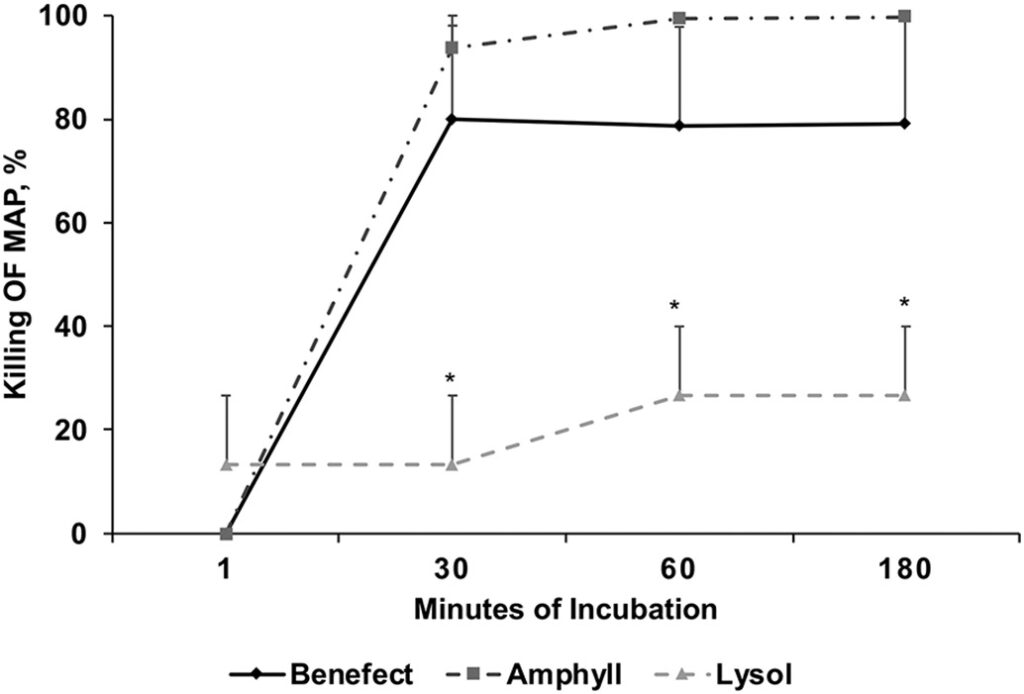
Comment: One of the more common questions from animal owners concerns disinfection of animal facilities after discovery of a MAP-infected animal. This new research gives a new and safer option for disinfection. Thank you Dr. Stabel!
ANTI-MAP FOR KIDS WITH CROHN’S
2020-07-25 15:48:07Drs. Agrawal, Hamblin, Clancy & Borody from the Research Department, Centre for Digestive Diseases, Five Dock, NSW, Australia describe successfully treating Crohn’s disease in children with anti-MAP antibiotics. Their publication, titled “Anti-Mycobacterial Antibiotic Therapy Induces Remission in Active Paediatric Crohn’s Disease” appears in the July 24, 2020 issue of Microorganisms.
Abstract
Crohn’s disease is increasing in incidence and prevalence in younger people and is of a particularly aggressive nature. One emerging treatment targets Mycobacterium avium paratuberculosis (MAP), an organism implicated in the causation of Crohn’s disease. This study reviewed a cohort of paediatric patients with active Crohn’s disease treated with Anti-Mycobacterial Antibiotic Therapy (AMAT). Sixteen paediatric patients, the majority of whom had failed conventional immunosuppressive therapy, were treated with AMAT. Endoscopic remission was scored using the Simple Endoscopic Score for Crohn’s Disease and clinical remission was assessed using the Weighted Paediatric Crohn’s Disease Activity Index (wPCDAI). Inflammatory blood markers were also routinely recorded. Patients were followed up clinically and endoscopically during treatment after an average of two months (range 1–6) and 17 months (range 2–49), respectively. A significant reduction in both scores assessing clinical improvement (p < 0.001) and mucosal healing (p < 0.0078) was observed at these timepoints; 47% of patients had achieved clinical remission and 63% endoscopic remission. Haemoglobin and serum inflammatory markers normalised for more than 50% of the cohort by six months of treatment. No adverse effects were reported throughout treatment. This is the first report of Anti-Mycobacterial Antibiotic Therapy offering a safe and efficacious therapy for paediatric patients with Crohn’s disease. Further larger randomised studies are required in order to validate these findings.
Author's Conclusions:
Despite a well-documented aggressive disease presentation and a recent exponential rise in the incidence of paediatric CD, fewer therapies are available in children when compared to the adult population. We examined the safety and efficacy of a combination antibiotic regime consisting of rifabutin, clofazimine and clarithromycin targeting MAP, a proposed contributing factor in the pathogenesis of CD. This study provides a valuable and novel proof of concept regarding the applicability of AMAT to a broad range of clinical presentations in paediatric Crohn’s disease patients. We report no significant side effects as a result of a dose escalated, sustained antibiotic regimen and suggest that AMAT may be more efficacious in the treatment of childhood onset compared with adult onset CD. Furthermore, we observed a notable trend, which proposes that the extent of prior immunosuppressive therapy may predict a longer treatment course with AMAT. Future targeted and more robust RCTs should also focus on sub-populations in terms of disease severity, extent of prior treatment and the time since initial diagnosis prior to the commencement of AMAT.
Comment: Read this for more about MAP in food and water and a list of 29 references to scientific literature. Given the weight of evidence and the severity and magnitude of potential human health problems, the precautionary principle suggests that it is time to take actions to limit “as low as reasonably achievable” human exposure to MAP. Only by controlling MAP in food producing animals can we stop the ongoing exposure of humans to MAP through the food supply.
« Previous 1 … 6 7 8 9 10 … 18 Next »